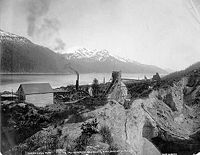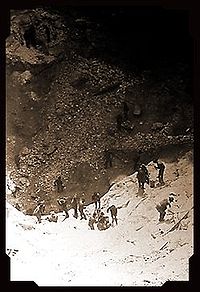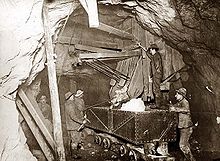
Treadwell gold mine
Encyclopedia

Klondike Gold Rush
The Klondike Gold Rush, also called the Yukon Gold Rush, the Alaska Gold Rush and the Last Great Gold Rush, was an attempt by an estimated 100,000 people to travel to the Klondike region the Yukon in north-western Canada between 1897 and 1899 in the hope of successfully prospecting for gold...
, although Treadwell had twelve years of experience in both placer and lode mines previously. The mine was composed of four sub-sites and at its peak employed over 2000 people.
The Treadwell mine is located on the north side of Douglas Island
Douglas Island
Douglas Island is a tidal island in the U.S. state of Alaska, just west of downtown Juneau and east of Admiralty Island. It is separated from mainland Juneau by the Gastineau Channel. The Juneau-Douglas Bridge, connecting the island with Juneau, provides a two lane road to and from the island and...
half a mile away from the town of Douglas, Alaska
Douglas, Alaska
Douglas, Alaska is an area on Douglas Island in southeastern Alaska. Itoriginated in 1881 as a place providing services to miners of the nearby Treadwell gold mine, and was incorporated as a city in 1902. Douglas was once a larger town than neighboring Juneau, but dwindled in the early 1900s as...
, just south east of downtown Juneau, Alaska
Juneau, Alaska
The City and Borough of Juneau is a unified municipality located on the Gastineau Channel in the panhandle of the U.S. state of Alaska. It has been the capital of Alaska since 1906, when the government of the then-District of Alaska was moved from Sitka as dictated by the U.S. Congress in 1900...
, of which Douglas has been a part since merging with Juneau in 1970. Not much remains of the mine today except for a few crumbling buildings and a "glory hole".
Beginnings

Joe Juneau (prospector)
Joseph Juneau was a miner and prospector from Canada who was born in the Quebec town of Saint-Paul-l'Ermite to François Xavier Juneau dit Latulippe and Marguerite Thiffault Juneau. He is best known for co-founding, with Richard Harris, the city of Juneau, Alaska, United States...
and Richard Harris
Richard Harris (prospector)
Richard Tighe Harris was a Canadian miner and prospector.Richard Harris was born in Dummadonald, County Down, Ireland. However, attended Girard College, a private boarding school in Philadelphia, PA ....
discovered gold in Silver Bow Basin
Silver Bow Basin
The Silver Bow Basin is a valley located northeast of Juneau, Alaska, USA. It is situated on Gold Creek in an area north of Icy Gulch, and approximately north of Gastineau Peak. A trail from Juneau leads directly to the mountainside...
. This discovery of gold brought waves of prospectors to the region including John Treadwell. John Treadwell's first move on coming to Alaska was to purchase a lode claim on Douglas Island from Pierre Joseph Erussard de Ville. Treadwell also formed a partnership with three men ( Erussard de Ville, D.P. Mitchell and Dave Martin ) under the name the San Francisco Company in September 1881. For unknown reasons he later backed out of this, and in early December 1881 he devoted his attention solely to the Douglas Island property. He then went on to buy two claims neighboring his property from D. W. Clark. Treadwell extracted twenty two samples from his three claims which he sent to San Francisco, California for a mill test, yielding encouraging results. On December 27, 1881, Treadwell organized the Alaska Mill & Mining Company and began operations at the Treadwell Dike. Shortly after this, five men from California bought over $10,000 worth of stock in the business. These men were James Freeborn ( 1828 - June 21, 1894 ), San Francisco banker and mining magnate John D. Fry (July 1, 1819 - Feb. 3, 1901 ) ( Fry's full name was John Douglas Fry ), Horace Lewis Hill (1840 - Nov. 6, 1912 ), Howard Hill Shinn ( born April 4, 1857 ) and E. M. With these men funding him, Treadwell began running a tunnel and discovered that much of the vein he was mining was not on his property. Because the word about his strike had not yet gotten out he was able to buy many of the adjoining claims for very little money after which he returned to San Francisco to acquire more money to put in a much larger mill. His financial benefactors agreed to invest more and the major mining operation had begun.
In 1889, Treadwell sold his stake in the company for $1.5 million and returned to California.
Operation

Machine press
A machine press, commonly shortened to press, is a machine tool that changes the shape of a workpiece.-Servomechanism:A servomechanism press, also known as a servo press or a electro press, is a press driven by an AC servo motor. The torque produced is converted to a linear force via a ball screw....
in continuous operation. These mills were fed by four separate mines known as the Treadwell, 700-Foot, Mexican and Ready Bullion. At this time the mine employed over 2,000 people and had the largest mill in the world. The gold mined was 55% free milling and 45% embedded within pyrite. The gold in the pyrite was extracted in three different ways; chlorination
Chlorination
Chlorination is the process of adding the element chlorine to water as a method of water purification to make it fit for human consumption as drinking water...
, smelting
Smelting
Smelting is a form of extractive metallurgy; its main use is to produce a metal from its ore. This includes iron extraction from iron ore, and copper extraction and other base metals from their ores...
, and cyanidation
Gold cyanidation
Gold cyanidation is a metallurgical technique for extracting gold from low-grade ore by converting the gold to a water soluble coordination complex. It is the most commonly used process for gold extraction...
. Power to the complex was supplied by a coal fired power plant that was later switched to oil and two electric dams.
Some of the shafts extended as much as 2,400 feet below the surface.
Decline
The mine was still yielding gold until 1917. In 1917 the Treadwell, 700-Foot, and Mexican Mines which had been excavated to a depth of more than 500ft below sea level suddenly began leaking, and had to be evacuated. Hours later the mine collapsed. Fortunately no miners where killed because everyone had been evacuated long before the collapse, the only fatalities were a dozen horses and one mule. At the climax, the collapse sent sprays of water up to 200 ft in to the air from the mine's entrances.Evidence of instability was noticed first around 1909 but there had been no clues of the impending disaster until 1913, when major geological shifts occurred. Reinforcements were constructed but as shown by the eventual collapse, it was ineffective. The last shaft continued to operate until 1922, although only in a limited fashion.
Online
- Treadwell family history
- Bureau of Land Management
- Treadwell mine City of Juneau official history site
Printed
- Hard Rock Gold by David & Brenda Stone, Vanguard Press, 1987
- "History of the Mines & Miners in the Juneau Gold Belt" by Earl Redman, 1988.
- The Birdman of Treadwell: Diary of a Treadwell Gold Miner by Edwin Warren with Barry Kibler (ISBN 9781425960643)
External links
- Collection of photographs of the mine
- Photos from the Alaska State Library
- Photo of the Treadwell Mine University of Washington Digital Library
- History of Albert Aris Family history site by Mark Howells

